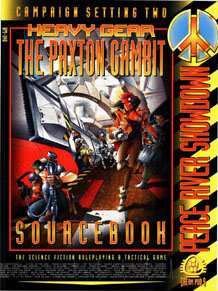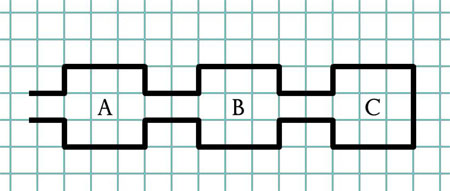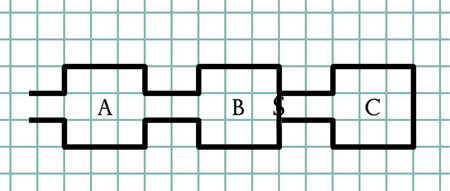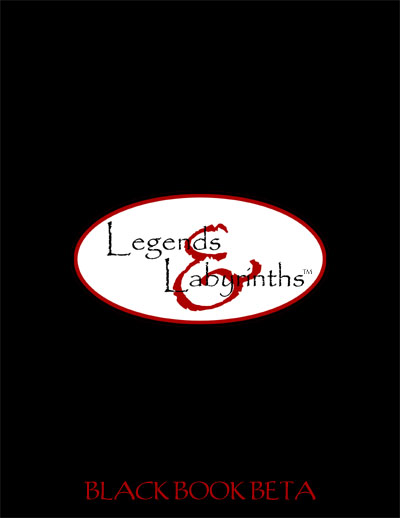Way back on July 4th, 2005, I launched the Alexandrian with the cleverly titled post “Welcome to the Alexandrian“. In that post, I talked about how I had become a freelance writer. The 100+ reviews I wrote for RPGNet played a major role in that story, but I wrapped up my post by saying: “But if you go to RPGNet today, you won’t find any of my reviews there. What happened? Well, that’s another story for another day.”
Then I didn’t really follow-up on that, largely because there were more interesting things to talk about.
But I’ve had people pinging me for awhile now wanting access to some of the content from my older reviews. And the original (and continuing) purpose of the Alexandrian is to archive my creative work. To that end, I’m going to start posting those old reviews in order to properly archive them away. Which means that “another day” has finally arrived.
THE  REVIEWS
REVIEWS
I posted my first review to RPGNet in the spring of 1998.
It was a review of The Paxton Gambit, a campaign supplement for the Heavy Gear roleplaying game, and it had originally been written for and posted to the Heavy Gear Mailing List. RPGNet had been around for a couple of years at that point, but the site was just beginning to get noticed by the larger RPG community. One of the people who noticed was Phillippe Boulle, who — at the time — was an editor at Dream Pod 9. He, in turn, posted a message to the Heavy Gear Mailing List asking that fans of the game go to RPGNet and post reviews of their favorite Dream Pod 9 products. When I saw Phillippe’s message, I took the review I had already written, popped over to RPGNet, and posted it.
That was a lot of fun and, to make a long story short, I kept doing it. In fact, over the next four years I would do it 165 times.
In those early days, the RPGNet community was heavily focused on the reviews: There was no general forum, but there was a discussion thread associated with each review. That meant that all of the discussion on the site was focused through whatever reviews had been posted in the last couple of weeks. It meant that the community was radically neophilic and intensely focused on RPGs.
It also meant that, if you were a successful reviewer, you were the genesis point for sprawling discussions that could go on for dozens or even hundreds of posts.
In retrospect, it’s pretty easy to recognize that RPGNet was actually serving as one of the pioneers in the newly-emerging blogosphere: Each review was effectively a blog post and the emergent community was blog-focused. At the time, it was just exciting. I’d been participating in online discussion groups since 1988 or ’89; but here I was actually finding an audience.
 From ’98 through ’02, I was one of the top three or four reviewers on RPGNet. During this time period, the site went through several changes of ownership, one of which nearly destroyed the site before it was returned to Sandy Antunes (the founder). In 2001, it was then sold to Skotos Tech.
From ’98 through ’02, I was one of the top three or four reviewers on RPGNet. During this time period, the site went through several changes of ownership, one of which nearly destroyed the site before it was returned to Sandy Antunes (the founder). In 2001, it was then sold to Skotos Tech.
Throughout this time period I continued writing reviews. In May 2001, in fact, the site ran a “Justin Bacon Review Week” in which all of the reviews posted that week (20+ total) were written by me. That was pretty awesome and I felt very honored. Around this same time, I was asked by Sandy Antunes to help develop content for a D20 Nation website that he wanted to launch as a partner-site with RPGNet. (Unfortunately, those plans never came to fruition.)
The site was also changing, however.
Forum software had been installed at some point. This was almost certainly a good thing (the site would have probably died completely during the period when its owners weren’t updating the content if it hadn’t been for the forum), but it also meant that the character of the site was changing: The community was becoming forum-oriented instead of review-oriented.
(One memory from this time period in particular: The early forum software didn’t have any accounts. You just typed in your name and left your message. There was a period of a couple weeks where somebody was deliberately trolling the forums by posting incendiary posts under my name. It took me awhile to figure out what the heck was going on, and eventually the guy responsible confessed. I suspect this incident contributed significantly to the site updating to new forum software with registered accounts shortly thereafter.)
In mid-2002, I posted what was essentially my last review at RPGNet. (In mid-2004, I posted a review of A Game of Thrones. But it was a fluke.) Partly this was because professional work was chewing up more and more of my time. Partly it was because the RPG review community had completely fetishized the reviewing of typography and binding quality instead of actual content and gameplay. But largely it was because the audience for reviews at RPGNet had severely atrophied.
PARTING OF THE WAYS
I remained an active member of the RPGNet community, however, until 2004.
In October 2003, I was participating in a thread where somebody was voicing incredulity at the idea of someone owning more than a hundred RPGs, claiming that a hundred RPGs didn’t even exist. I pointed out that hundreds of free RPGs were available on the web; so you could own hundreds of RPGs without even spending a dollar. After a couple rounds of this, I compiled and typed up a very lengthy list of the free RPGs I owned and posted it. This took about 2-3 hours worth of effort.
This list prompted several pages worth of interesting discussion. Several days later, however, one of the forum moderators did a drive-by on the thread and deleted the entire post as “threadcrapping”. I was irate at having 2-3 hours of work eradicated and responded with, “Fuck You.”
 In retrospect, I probably should have saved a local copy of the post. And I probably could have been more politic in my response to the atrociously poor moderation. But I wasn’t and I got hit with a 90-day ban for mouthing off to the incompetent moderator.
In retrospect, I probably should have saved a local copy of the post. And I probably could have been more politic in my response to the atrociously poor moderation. But I wasn’t and I got hit with a 90-day ban for mouthing off to the incompetent moderator.
Several months later, after the ban had expired, I came back and found that I couldn’t log into my account. Reconstructing events after the fact, it appears that one of the moderators (probably a fellow operating under the name “Kuma”) had decided to change the password and e-mail address on my account in an effort to secretly turn a temporary ban into a permanent one. E-mails to RPGNet went unanswered, so I created a new account under the name “Justin A. Bacon” and continued posting.
In August or September of 2004, Kuma started trying to IP ban me from the forum. Since I was posting from a dynamic IP, this completely failed. (I wasn’t even aware he was doing it, since he’d posted his intentions in a thread I was no longer reading.) After several weeks of this, another moderator apparently got around to banning the “Justin A. Bacon” account for “avoiding a ban”. (This was, of course, completely untrue. For several years after this it was quite hilarious because the “Justin Bacon” account had still never been banned, although it looks like they finally got around to “fixing” that recently.)
I sent an e-mail to the site and was told to wait a couple of days for the issue to be resolved. After a week or so, it hadn’t been.
At this point I posted to Trouble Tickets asking for an explanation. None was forthcoming. It took several days and many other people posting to both the forum thread and e-mailing RPGNet before they finally got around to posting their explanation: They believed that I had posted at some point during my 90-day ban and were, therefore, permabanning me.
Did they have a link to that post? No.
Could they find a link to that post? No.
Was there any way to fix this issue? Yes. Within 1-2 days, they would confirm the existence or nonexistence of the post Kuma claimed it existed.
… only they didn’t do that. Instead they closed the thread so that no one could post to it.
A month and a half later, somebody else posted a thread asking: “Hey. What’s going on here?” The moderators still had no explanation.
During this time period, I was being contacted by others. Something was deeply, deeply rotten in the moderation team at RPGNet and I wasn’t the only one having problems.
I decided to raise the stakes: I publicly announced that if RPGNet didn’t want me as a member of the community, then I would pull my reviews.
The point was to raise the profile not only of my issues with the moderation team, but the general issues the community was having with the moderation team. I was hoping that it would force the new owners of the site to put their cards of the table and make it clear what sort of site RPGNet was going to be. In this I was successful, although not in the way that I had hoped: Still unable to produce the posts demonstrating that there was any justification whatsoever for my permabanning, the owners of the site instead permabanned me for daring to exercise my IP rights.
I shrugged and walked away. The RPGNet I had once fervently supported was obviously dead and gone.
POSTSCRIPT
 I do remember quite vividly, though, my final e-mail exchange with the ownership. They wanted to give me “one last chance” to let them keep my reviews on the site. They wrote: “By removing them from RPGNet, you’re destroying the value of your reviews.”
I do remember quite vividly, though, my final e-mail exchange with the ownership. They wanted to give me “one last chance” to let them keep my reviews on the site. They wrote: “By removing them from RPGNet, you’re destroying the value of your reviews.”
This taught me an important lesson: When an organization believes that your work has value because they allow it to appear in their venue (rather than the reality, which is that the content is what gives a venue value) then you’re probably better off getting away from that organization as quickly as possible.
In the years since then, the situation at RPGNet has only worsened. The Tangency forums have become the tail wagging the dog. There are members of the moderation team who take great pride in the fact that they’ve never played an RPG. (This fact boggles my mind every time somebody mentions it.)
The site, which once made its name on the participation of major RPG professionals (priding itself as the “Inside Scoop on Gaming”), has become increasingly hostile to them. It’s becomes a popular past time for posters to bait professionals posting to the boards so that the professionals will get banned. At one point, this was coupled with a ludicrous policy of banning discussions of games written by people who had been banned.
A couple years ago a friend of mine told me he was being accused by RPGNet’s mods of being my sock-puppet because he included links to products I had written (and he had helped edit) in his .sig. Last year I had a complete stranger send me an e-mail saying that RPGNet’s mods were making the same accusations towards him.
I’m not sure what to tell either of them. I enjoy discussing and debating RPGs. It improves my games. It improves my writing.
But RPGNet? It’s a cesspool. And, sadly, it’s a cesspool that’s been created by the very mechanism which is supposed to be keeping the water clean.
In any case, that’s the nutshell version of my rollercoaster ride with RPGNet. Hopefully you found it at least mildly entertaining. But mostly it’s my way of introducing the reposting and archiving of the reviews I wrote for RPGNet “back in the day”. I’ll be starting later today and posting them semi-regularly until I’m done.


 From ’98 through ’02, I was one of the top three or four reviewers on RPGNet. During this time period, the site went through several changes of ownership, one of which nearly destroyed the site before it was returned to Sandy Antunes (the founder). In 2001, it was then sold to Skotos Tech.
From ’98 through ’02, I was one of the top three or four reviewers on RPGNet. During this time period, the site went through several changes of ownership, one of which nearly destroyed the site before it was returned to Sandy Antunes (the founder). In 2001, it was then sold to Skotos Tech. I do remember quite vividly, though, my final e-mail exchange with the ownership. They wanted to give me “one last chance” to let them keep my reviews on the site. They wrote: “By removing them from RPGNet, you’re destroying the value of your reviews.”
I do remember quite vividly, though, my final e-mail exchange with the ownership. They wanted to give me “one last chance” to let them keep my reviews on the site. They wrote: “By removing them from RPGNet, you’re destroying the value of your reviews.”












